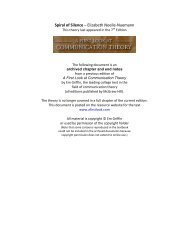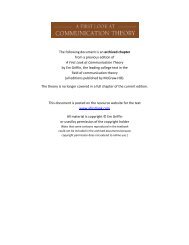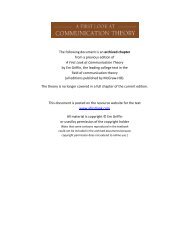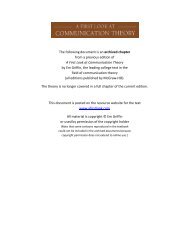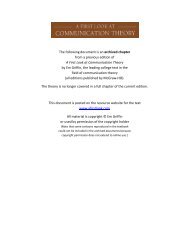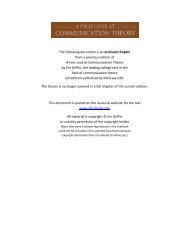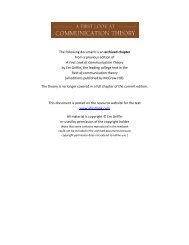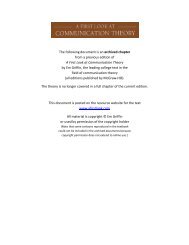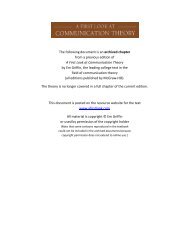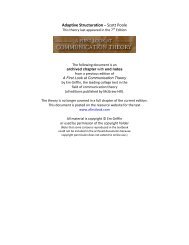Attribution Theory of Fritz Heider - A First Look at Communication ...
Attribution Theory of Fritz Heider - A First Look at Communication ...
Attribution Theory of Fritz Heider - A First Look at Communication ...
Create successful ePaper yourself
Turn your PDF publications into a flip-book with our unique Google optimized e-Paper software.
Step 1: Perception <strong>of</strong> the Action<br />
ATTRIBUTION THEORY 139<br />
The courtroom was on the twenty-first floor <strong>of</strong> the Federal Building. A well-<br />
dressed, handsome man carrying a bag <strong>of</strong> donuts dashed toward the elev<strong>at</strong>or<br />
just as the doors were closing. I slapped my hand against the breaker bar to<br />
hold the car, receiving enthusiastic words <strong>of</strong> thanks and the <strong>of</strong>fer <strong>of</strong> a donut.<br />
We traded a few friendly comments until we got <strong>of</strong>f <strong>at</strong> the same floor. It<br />
turned out we were both headed for the south courtroom. A few minutes<br />
l<strong>at</strong>er I learned th<strong>at</strong> his name was Brian, and I also heard testimony <strong>of</strong> how he<br />
used a Louisville Slugger to be<strong>at</strong> up a cocaine addict who hadn’t paid for his<br />
drug.<br />
Was Brian observed? Yes, Larry was an eyewitness and gave an account<br />
<strong>of</strong> the act. My perception was secondhand through Larry’s description, but<br />
Jean had told me the night before th<strong>at</strong> she thought Larry was a credible<br />
witness. My vicarious observ<strong>at</strong>ion <strong>of</strong> the scene triggered the start <strong>of</strong> the<br />
<strong>at</strong>tribution chain. If I hadn’t heard the story, the process would never have<br />
started.<br />
I’m sure th<strong>at</strong> my perception <strong>of</strong> the action was subject to all the biases<br />
listed in the introduction to this section. It was initially difficult to picture<br />
such a brutal act performed by Brian because th<strong>at</strong> contradicted my initial<br />
image <strong>of</strong> a generous, joking Brian. This first impression, which was formed<br />
on the elev<strong>at</strong>or, was one <strong>of</strong> warmth, a trait th<strong>at</strong> casts a halo over all other<br />
qualities.<br />
I like to think <strong>of</strong> myself as a good judge <strong>of</strong> character, so my continuing<br />
desire to see Brian in a favorable light could well have compromised the<br />
integrity <strong>of</strong> my courtroom listening. Th<strong>at</strong>’s why jurors are excused “for<br />
cause” when personal motiv<strong>at</strong>ion prevents their being impartial. Despite<br />
these biases, the new inform<strong>at</strong>ion crashed into my world and I moved to the<br />
second stage <strong>of</strong> causal <strong>at</strong>tribution.<br />
Step 2: Judgment <strong>of</strong> Intention<br />
Since Larry’s words convinced me th<strong>at</strong> Brian was present when the man was<br />
struck with a b<strong>at</strong>, the next question was, To wh<strong>at</strong> extent had Brian wanted it<br />
done? Th<strong>at</strong> may sound like a strange way to ask the question, but <strong>Heider</strong><br />
didn’t consider intention as an either-or m<strong>at</strong>ter. He identified five sliding<br />
scale positions <strong>of</strong> personal caus<strong>at</strong>ion. We can see these grad<strong>at</strong>ions reflected in<br />
the American legal code. Suppose for a moment th<strong>at</strong> the victim had died. Our<br />
judgment <strong>of</strong> intention could place the killing blow into five different c<strong>at</strong>ego-<br />
ries before the law.1<br />
1. Associ<strong>at</strong>ion. Despite the testimony, maybe Brian didn’t direct the<br />
<strong>at</strong>tack, swing the b<strong>at</strong>, or even know the man who did. He was merely in the<br />
vicinity <strong>at</strong> the time. Chance proximity is no reason to assign causality. We<br />
hope we are past the stage <strong>of</strong> killing the messenger who brings bad news. To<br />
impute guilt by associ<strong>at</strong>ion would be irr<strong>at</strong>ional. Not guilty.



